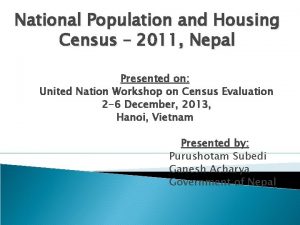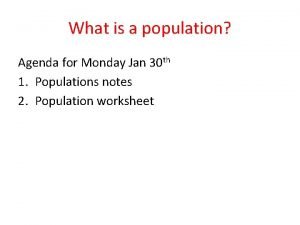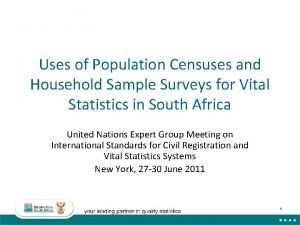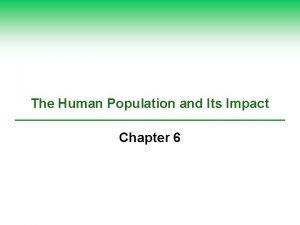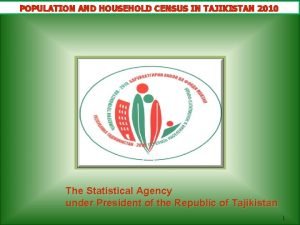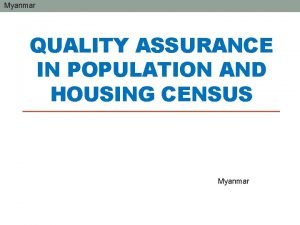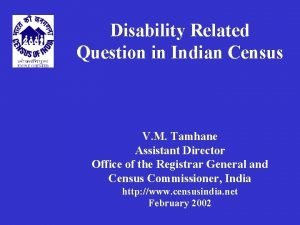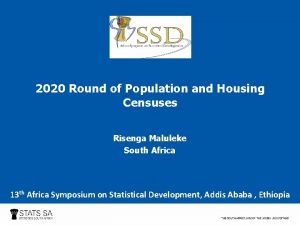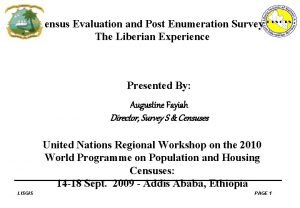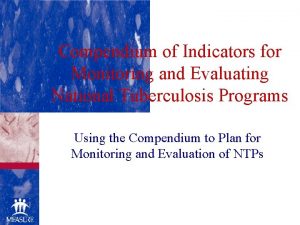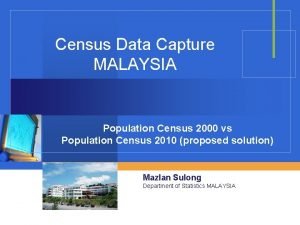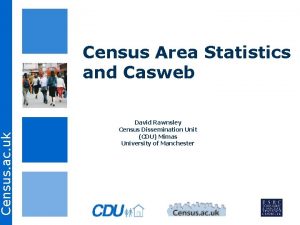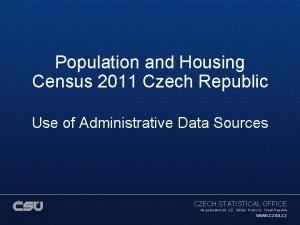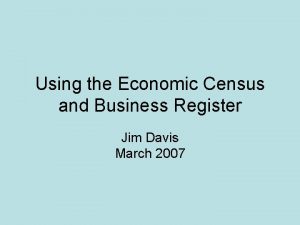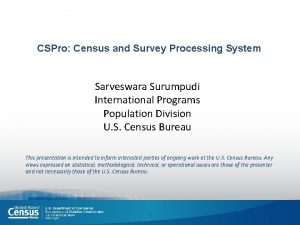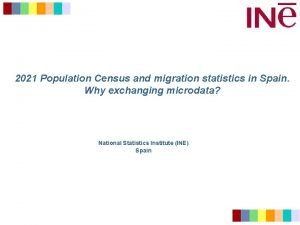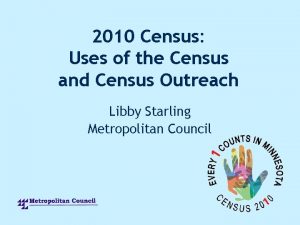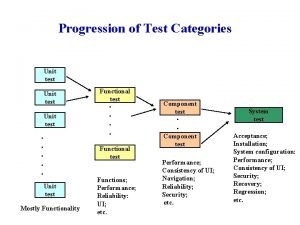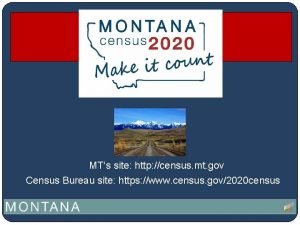Unit 2 Test Review Why is the census

































































































- Slides: 97

Unit 2 Test Review

Why is the census important in the United States? A. Immigrants without proper documentation can be deported B. Statistic of sampling reveal that homeless people are overcounted, especially in cities C. Some legislative seats, including those in the House of Representatives, are apportioned according to population D. Every vote counts in the presidential election E. The U. S. democratic process is never influenced by corporations or corporate money

Why is the census important in the United States? A. Immigrants without proper documentation can be deported B. Statistic of sampling reveal that homeless people are overcounted, especially in cities C. Some legislative seats, including those in the House of Representatives, are apportioned according to population D. Every vote counts in the presidential election E. The U. S. democratic process is never influenced by corporations or corporate money

An area of permanent human settlement is called the A. Hot zone B. Civilized world C. Geophenom D. Ecumene E. Subpolar region

An area of permanent human settlement is called the A. Hot zone B. Civilized world C. Geophenom D. Ecumene E. Subpolar region

The countries depicted as smaller on a population cartogram have A. Higher levels of wealth and higher populations B. Lower levels of wealth and higher populations C. Lower populations D. Lower populations and lesser land areas E. Lower technical proficiency in cartography and geospatial reasoning

The countries depicted as smaller on a population cartogram have A. Higher levels of wealth and higher populations B. Lower levels of wealth and higher populations C. Lower populations D. Lower populations and lesser land areas E. Lower technical proficiency in cartography and geospatial reasoning

Relatively few people live at ____, but there are significant exceptions, especially in Latin America. A. Low elevations B. Sea-level C. High elevations D. Or near coastlines E. The poles

Relatively few people live at ____, but there are significant exceptions, especially in Latin America. A. Low elevations B. Sea-level C. High elevations D. Or near coastlines E. The poles

Among the following world regions, the least densely populated is A. East Asia B. Southeast Asia C. Sub-Saharan Africa D. Europe E. South Asia

Among the following world regions, the least densely populated is A. East Asia B. Southeast Asia C. Sub-Saharan Africa D. Europe E. South Asia

Physiological density is the number of A. Acres of farmland per the total area of a country B. Farmers per area of farmland C. People per area of flat land D. People per area suitable for agriculture E. Farm animals per area suitable for agriculture

Physiological density is the number of A. Acres of farmland per the total area of a country B. Farmers per area of farmland C. People per area of flat land D. People per area suitable for agriculture E. Farm animals per area suitable for agriculture

Land suited for agriculture is called A. Population density B. Agricultural density C. Physiological land D. Arid land E. Arable land

Land suited for agriculture is called A. Population density B. Agricultural density C. Physiological land D. Arid land E. Arable land

A country can increase its physiological density by A. Increasing the amount of agricultural land B. Limiting the number of farmers C. Increasing the areas of its urban centers D. Increasing the size of its population E. Limiting the number of farm animals

A country can increase its physiological density by A. Increasing the amount of agricultural land B. Limiting the number of farmers C. Increasing the areas of its urban centers D. Increasing the size of its population E. Limiting the number of farm animals

A country with a large amount of arable land a small number of farmers will have a A. High physiological density B. Low physiological density C. High agricultural density D. Low agricultural density E. Low arithmetic density

A country with a large amount of arable land a small number of farmers will have a A. High physiological density B. Low physiological density C. High agricultural density D. Low agricultural density E. Low arithmetic density

The average number of births women bear in their lifetime is A. Total birth rate B. Crude birth rate C. Total fertility rate D. Total increase rate E. Crude fertility rate

The average number of births women bear in their lifetime is A. Total birth rate B. Crude birth rate C. Total fertility rate D. Total increase rate E. Crude fertility rate

The fertility rate based on the number of live births per 1, 000 residents is the A. Crude birth rate B. Crude fertility rate C. Infant birth rate D. Natural increase rate E. Life expectancy at birth

The fertility rate based on the number of live births per 1, 000 residents is the A. Crude birth rate B. Crude fertility rate C. Infant birth rate D. Natural increase rate E. Life expectancy at birth

The world’s annual _______ is currently approximately 1. 2%, at which rate the world’s population would double in about 54 years. A. Natural increase rate B. Life expectancy rate C. Crude birth rate D. Life increase rate E. Natural expectancy rate

The world’s annual _______ is currently approximately 1. 2%, at which rate the world’s population would double in about 54 years. A. Natural increase rate B. Life expectancy rate C. Crude birth rate D. Life increase rate E. Natural expectancy rate

Life expectancy is lower on average in A. Africa B. East Asia C. North America D. Europe E. Southeast Asia

Life expectancy is lower on average in A. Africa B. East Asia C. North America D. Europe E. Southeast Asia

500 babies were born in Narnia in 2015, but 35 of them died before reaching their first birthday. This information can be used to report Narnia’s A. Crude death rate B. Infant mortality rate C. Early life expectancy D. Murder rate E. Terminal increase rate

500 babies were born in Narnia in 2015, but 35 of them died before reaching their first birthday. This information can be used to report Narnia’s A. Crude death rate B. Infant mortality rate C. Early life expectancy D. Murder rate E. Terminal increase rate

Costa Rica has a lower crude death rate than the U. S. because Costa Rica A. Has a higher sex ratio B. Has more hospitals person C. Has a milder climate D. Is in Stage 4 of the demographic transition E. Has a lower percentage of elderly people

Costa Rica has a lower crude death rate than the U. S. because Costa Rica A. Has a higher sex ratio B. Has more hospitals person C. Has a milder climate D. Is in Stage 4 of the demographic transition E. Has a lower percentage of elderly people

Country A has a CBR of 60, and a CDR of 15. What is country A’s NIR? A. 75% B. 45% C. 7. 5% D. 4. 5% E. We don’t have enough information

Country A has a CBR of 60, and a CDR of 15. What is country A’s NIR? A. 75% B. 45% C. 7. 5% D. 4. 5% E. We don’t have enough information

The shape of a country’s population pyramid A. Is determined primarily by its crude birth rate B. Has no correlation to its crude birth rate C. Cannot be used to estimate a country’s dependency ratio D. Cannot be used to estimate a country’s sex ratio E. Is determined primarily by the combination of its crude birth rate and its crude growth rate.

The shape of a country’s population pyramid A. Is determined primarily by its crude birth rate B. Has no correlation to its crude birth rate C. Cannot be used to estimate a country’s dependency ratio D. Cannot be used to estimate a country’s sex ratio E. Is determined primarily by the combination of its crude birth rate and its crude growth rate.

A European country’s population pyramid would drastically change shape if it began to resemble A. The population pyramid of Japan B. The age-sex diagram of the United States C. The population pyramid of Nigeria D. The age-sex diagram of Australia E. The population pyramid of Canada

A European country’s population pyramid would drastically change shape if it began to resemble A. The population pyramid of Japan B. The age-sex diagram of the United States C. The population pyramid of Nigeria D. The age-sex diagram of Australia E. The population pyramid of Canada

The highest natural increase rates are found in countries in which stage of demographic transition? A. Stage 1 B. Stage 2 C. Stage 3 D. Stage 4 E. Stage 5

The highest natural increase rates are found in countries in which stage of demographic transition? A. Stage 1 B. Stage 2 C. Stage 3 D. Stage 4 E. Stage 5

The lowest crude birth rates are found in countries in which stage of demographic transition? A. Stage 1 B. Stage 2 C. Stage 3 D. Stage 4 E. Demographic transition is not effected by crude birth rates

The lowest crude birth rates are found in countries in which stage of demographic transition? A. Stage 1 B. Stage 2 C. Stage 3 D. Stage 4 E. Demographic transition is not effected by crude birth rates

The highest crude death rates are found in countries in which stage of demographic transition? A. Stage 1 B. Stage 2 C. Stage 3 D. Stage 4 E. Stage 5

The highest crude death rates are found in countries in which stage of demographic transition? A. Stage 1 B. Stage 2 C. Stage 3 D. Stage 4 E. Stage 5

Rapidly declining crude death rates are found in which stage of demographic transition? A. Stage 1 B. Stage 2 C. Stage 3 D. Stage 4 E. Stage 5

Rapidly declining crude death rates are found in which stage of demographic transition? A. Stage 1 B. Stage 2 C. Stage 3 D. Stage 4 E. Stage 5

Country X has a CBR of 40 and a CDR of 15. What stage of demographic transition are they in? A. Stage 1 B. Stage 2 C. Stage 3 D. Stage 4 E. Stage 5

Country X has a CBR of 40 and a CDR of 15. What stage of demographic transition are they in? A. Stage 1 B. Stage 2 C. Stage 3 D. Stage 4 E. Stage 5

Stages 1 and 4 of the Demographic Transition are similar in that A. Both have low growth rates B. Both have high dependency ratios C. Both have low dependency ratios D. Both have low life expectancies E. Both have low death rates

Stages 1 and 4 of the Demographic Transition are similar in that A. Both have low growth rates B. Both have high dependency ratios C. Both have low dependency ratios D. Both have low life expectancies E. Both have low death rates

Thomas Malthus concluded that A. Population increased arithmetically while food production increased linguistically B. The world’s rate of population increase was higher than the development of food supply C. So-called “moral restraint” was producing lower crude birth rates D. Population growth was outpacing available resources in every country E. Crude birth rates must balance crude death rates

Thomas Malthus concluded that A. Population increased arithmetically while food production increased linguistically B. The world’s rate of population increase was higher than the development of food supply C. So-called “moral restraint” was producing lower crude birth rates D. Population growth was outpacing available resources in every country E. Crude birth rates must balance crude death rates

The two most populous countries in the world are A. China and India B. India and Bangladesh C. Russia and the United States D. Indonesia and China E. The United States and China

The two most populous countries in the world are A. China and India B. India and Bangladesh C. Russia and the United States D. Indonesia and China E. The United States and China

A possible stage 5 epidemiological transition is the stage of A. Pestilence and famine B. Receding pandemics C. Degenerative and human-created diseases D. Delayed degenerative diseases E. Reemergence of infectious and parasitic diseases

A possible stage 5 epidemiological transition is the stage of A. Pestilence and famine B. Receding pandemics C. Degenerative and human-created diseases D. Delayed degenerative diseases E. Reemergence of infectious and parasitic diseases

The term ______ refers to the control of diseases A. Transition B. Medicology C. Pandemiology D. Epidemiology E. Infectionical

The term ______ refers to the control of diseases A. Transition B. Medicology C. Pandemiology D. Epidemiology E. Infectionical

The most lethal epidemic in recent years has been A. Avian Flu B. AIDS C. Malaria D. Cholera E. SARS

The most lethal epidemic in recent years has been A. Avian Flu B. AIDS C. Malaria D. Cholera E. SARS

A country has a net in-migration if immigration _______ emigration. A. Equals B. Exceeds C. Is closer to net migration than D. Is less than E. Varies more than

A country has a net in-migration if immigration _______ emigration. A. Equals B. Exceeds C. Is closer to net migration than D. Is less than E. Varies more than

Refugees migrate primarily because of what type of push factor? A. Economic B. Environmental C. Cultural D. Circulation E. All of the above

Refugees migrate primarily because of what type of push factor? A. Economic B. Environmental C. Cultural D. Circulation E. All of the above

Wilber Zelinsky’s model of migration predicted A. Women are more likely to migrate than men B. Long migration distances are more likely than short ones C. Migration characteristics vary with the demographic transition D. Intraregional migration is more important that interregional migration in terms of political and economic resources E. Migrant move most frequently for economic reasons

Wilber Zelinsky’s model of migration predicted A. Women are more likely to migrate than men B. Long migration distances are more likely than short ones C. Migration characteristics vary with the demographic transition D. Intraregional migration is more important that interregional migration in terms of political and economic resources E. Migrant move most frequently for economic reasons

The migration transition model predicts that international emigration reaches a peak at _______ of the demographic transition? A. Stage 1 B. Stage 2 C. Stage 3 D. Stage 4 E. Stage 5

The migration transition model predicts that international emigration reaches a peak at _______ of the demographic transition? A. Stage 1 B. Stage 2 C. Stage 3 D. Stage 4 E. Stage 5

The greatest number of foreignborn residents can be found in A. China B. Australia C. Germany D. The United Kingdom E. The United States

The greatest number of foreignborn residents can be found in A. China B. Australia C. Germany D. The United Kingdom E. The United States

The largest number of legal, documented immigrants in the United States come from what country? A. Cuba B. Mexico C. The Philippines D. South Korea E. Germany

The largest number of legal, documented immigrants in the United States come from what country? A. Cuba B. Mexico C. The Philippines D. South Korea E. Germany

If your ancestors migrated to the U. S. during the 1840’s or 1850’s, barring any other evidence, you might strongly suspect they originated in A. Norway or England B. Ireland or Germany C. Italy of Portugal D. Spain or Portugal E. Russia or Bulgaria

If your ancestors migrated to the U. S. during the 1840’s or 1850’s, barring any other evidence, you might strongly suspect they originated in A. Norway or England B. Ireland or Germany C. Italy of Portugal D. Spain or Portugal E. Russia or Bulgaria

Norwegians were most likely to migrate to the United States A. Prior to 1840 B. During the 1840’s and 1850’s C. During the 1880’s and 1890’s D. During the U. S. Civil War E. Between 1900 and 1915

Norwegians were most likely to migrate to the United States A. Prior to 1840 B. During the 1840’s and 1850’s C. During the 1880’s and 1890’s D. During the U. S. Civil War E. Between 1900 and 1915

Recent immigrants to the United States A. Are nearly evenly distributed among all states B. Are distributed evenly along the southern U. S. border and the east and west coasts C. Are concentrated in Texas, California, and Illinois and are seldom in other areas D. Have not been attracted to rural and agricultural areas E. Are spread throughout several states according to economic prospects

Recent immigrants to the United States A. Are nearly evenly distributed among all states B. Are distributed evenly along the southern U. S. border and the east and west coasts C. Are concentrated in Texas, California, and Illinois and are seldom in other areas D. Have not been attracted to rural and agricultural areas E. Are spread throughout several states according to economic prospects

The U. S. center of population has moved steadily to the A. East B. North C. South D. West E. Center

The U. S. center of population has moved steadily to the A. East B. North C. South D. West E. Center

In the U. S. , which is likely to cause virtually all population growth in the next few decades? A. Natural increase rate B. Net in-migration C. Crude birth rate D. Declining death rates E. Urban expansion

In the U. S. , which is likely to cause virtually all population growth in the next few decades? A. Natural increase rate B. Net in-migration C. Crude birth rate D. Declining death rates E. Urban expansion

Which is a current intraregional migration trend in the U. S. ? A. Rural to urban B. Urban to suburban C. Metropolitan to nonmetropolitan D. Note emigration from the northeast E. All of the above

Which is a current intraregional migration trend in the U. S. ? A. Rural to urban B. Urban to suburban C. Metropolitan to nonmetropolitan D. Note emigration from the northeast E. All of the above

The Brazilian government encouraged interregional migration by A. Making Rio de Janeiro and Sao Paulo more attractive B. Dictating optimal locations for factories C. Clearing the rain forest for agricultural activities in the interior D. Moving the capital to Brasilia E. Industrial development on the Atlantic coast

The Brazilian government encouraged interregional migration by A. Making Rio de Janeiro and Sao Paulo more attractive B. Dictating optimal locations for factories C. Clearing the rain forest for agricultural activities in the interior D. Moving the capital to Brasilia E. Industrial development on the Atlantic coast

The most prominent type of intraregional migration in the world is A. North to south B. Region to region C. Urban to rural D. City to city E. Rural to urban

The most prominent type of intraregional migration in the world is A. North to south B. Region to region C. Urban to rural D. City to city E. Rural to urban

According to the United Nations High Commission for Refugees (UNHCR) in 2010, the largest number of refugees were forced to migrate from _____, which have seen a great deal of armed conflict in recent years. A. Vietnam and Indonesia B. Afghanistan and Iraq C. Sudan, South Africa, and Colombia D. Mexico and Colombia E. Ethiopia, Nicaragua, and Somalia

According to the United Nations High Commission for Refugees (UNHCR) in 2010, the largest number of refugees were forced to migrate from _____, which have seen a great deal of armed conflict in recent years. A. Vietnam and Indonesia B. Afghanistan and Iraq C. Sudan, South Africa, and Colombia D. Mexico and Colombia E. Ethiopia, Nicaragua, and Somalia

Braid drain is A. The large-scale emigration of talented people B. The process by which people are given reference for migration C. People forced to migrate for political reasons D. A cultural feature that hinders migration E. A net decline in literacy

Braid drain is A. The large-scale emigration of talented people B. The process by which people are given reference for migration C. People forced to migrate for political reasons D. A cultural feature that hinders migration E. A net decline in literacy

Why did migration to the U. S, decline during the 1920’s? A. Economic depression in the United States B. Forced migration after WWI C. Imposition of quota laws D. Declining demand for industrial workers E. Declining demand for domestic workers

Why did migration to the U. S, decline during the 1920’s? A. Economic depression in the United States B. Forced migration after WWI C. Imposition of quota laws D. Declining demand for industrial workers E. Declining demand for domestic workers

Most Asian migration to the U. S. is through the process of A. Expansion diffusion B. Brain drain C. Chain migration D. Undocumented immigration E. Global circulation

Most Asian migration to the U. S. is through the process of A. Expansion diffusion B. Brain drain C. Chain migration D. Undocumented immigration E. Global circulation

Mexico provides the U. S. with its largest numbers of A. Voluntary immigrants and political refugees B. Both legal and undocumented immigrants C. Laborers D. Refugees from natural disasters E. European and Asian migrants, accepting those who have entered from Guatemala

Mexico provides the U. S. with its largest numbers of A. Voluntary immigrants and political refugees B. Both legal and undocumented immigrants C. Laborers D. Refugees from natural disasters E. European and Asian migrants, accepting those who have entered from Guatemala
 Unit 10, unit 10 review tests, unit 10 general test
Unit 10, unit 10 review tests, unit 10 general test Algebra 2 unit 1 test answers
Algebra 2 unit 1 test answers Why why why why
Why why why why Don't ask why why why
Don't ask why why why Julius caesar test review
Julius caesar test review Hamlet unit test
Hamlet unit test Geometry unit test
Geometry unit test Unit 2 review algebra 1
Unit 2 review algebra 1 The crucible unit test review
The crucible unit test review Unit 1 test review us history
Unit 1 test review us history Foundations of american government unit test
Foundations of american government unit test Format asl
Format asl Romeo and juliet test
Romeo and juliet test Algebra 1 unit 6 review
Algebra 1 unit 6 review Census at school random sampler
Census at school random sampler Census disability question
Census disability question National population and housing census 2011
National population and housing census 2011 Caesar augustus issued a decree that a census
Caesar augustus issued a decree that a census Our census our future
Our census our future Census enumerator training
Census enumerator training Http://www.census.gov/popclock/
Http://www.census.gov/popclock/ Sample or census
Sample or census Foreign trade division us census bureau
Foreign trade division us census bureau Http://www.census.gov/popclock/
Http://www.census.gov/popclock/ School workforce census 2017
School workforce census 2017 Census definition
Census definition Www.dop.gov.mm http //myanmar.unfpa.org/census
Www.dop.gov.mm http //myanmar.unfpa.org/census Edhint
Edhint Census disability question
Census disability question Dexter data extraction
Dexter data extraction When we take a census we attempt to collect data from
When we take a census we attempt to collect data from Gif unpacking in census
Gif unpacking in census Census flows mapper
Census flows mapper Https://www.census.gov/popclock/
Https://www.census.gov/popclock/ Our census our future
Our census our future Liberia census 2008 results
Liberia census 2008 results Bird census techniques pdf
Bird census techniques pdf The census form
The census form Census definition
Census definition Advantages of census
Advantages of census Casweb census
Casweb census Respond census gov nscg
Respond census gov nscg School workforce census 2019
School workforce census 2019 Czech republic census 2011
Czech republic census 2011 Gender responsive census
Gender responsive census Sony market segmentation, targeting and positioning
Sony market segmentation, targeting and positioning Counter cats census
Counter cats census Census business register
Census business register New york regional census center
New york regional census center Cspro android
Cspro android Spain census 2021
Spain census 2021 Unit 4 lesson 7 right triangles and trigonometry unit test
Unit 4 lesson 7 right triangles and trigonometry unit test Hình ảnh bộ gõ cơ thể búng tay
Hình ảnh bộ gõ cơ thể búng tay Slidetodoc
Slidetodoc Bổ thể
Bổ thể Tỉ lệ cơ thể trẻ em
Tỉ lệ cơ thể trẻ em Gấu đi như thế nào
Gấu đi như thế nào Tư thế worms-breton
Tư thế worms-breton Hát lên người ơi
Hát lên người ơi Các môn thể thao bắt đầu bằng tiếng đua
Các môn thể thao bắt đầu bằng tiếng đua Thế nào là hệ số cao nhất
Thế nào là hệ số cao nhất Các châu lục và đại dương trên thế giới
Các châu lục và đại dương trên thế giới Công thức tính độ biến thiên đông lượng
Công thức tính độ biến thiên đông lượng Trời xanh đây là của chúng ta thể thơ
Trời xanh đây là của chúng ta thể thơ Cách giải mật thư tọa độ
Cách giải mật thư tọa độ 101012 bằng
101012 bằng Phản ứng thế ankan
Phản ứng thế ankan Các châu lục và đại dương trên thế giới
Các châu lục và đại dương trên thế giới Thơ thất ngôn tứ tuyệt đường luật
Thơ thất ngôn tứ tuyệt đường luật Quá trình desamine hóa có thể tạo ra
Quá trình desamine hóa có thể tạo ra Một số thể thơ truyền thống
Một số thể thơ truyền thống Cái miệng nó xinh thế chỉ nói điều hay thôi
Cái miệng nó xinh thế chỉ nói điều hay thôi Vẽ hình chiếu vuông góc của vật thể sau
Vẽ hình chiếu vuông góc của vật thể sau Nguyên nhân của sự mỏi cơ sinh 8
Nguyên nhân của sự mỏi cơ sinh 8 đặc điểm cơ thể của người tối cổ
đặc điểm cơ thể của người tối cổ Thế nào là giọng cùng tên
Thế nào là giọng cùng tên Vẽ hình chiếu đứng bằng cạnh của vật thể
Vẽ hình chiếu đứng bằng cạnh của vật thể Phối cảnh
Phối cảnh Thẻ vin
Thẻ vin đại từ thay thế
đại từ thay thế điện thế nghỉ
điện thế nghỉ Tư thế ngồi viết
Tư thế ngồi viết Diễn thế sinh thái là
Diễn thế sinh thái là Dạng đột biến một nhiễm là
Dạng đột biến một nhiễm là Số nguyên tố là
Số nguyên tố là Tư thế ngồi viết
Tư thế ngồi viết Lời thề hippocrates
Lời thề hippocrates Thiếu nhi thế giới liên hoan
Thiếu nhi thế giới liên hoan ưu thế lai là gì
ưu thế lai là gì Sự nuôi và dạy con của hươu
Sự nuôi và dạy con của hươu Sự nuôi và dạy con của hổ
Sự nuôi và dạy con của hổ Hệ hô hấp
Hệ hô hấp Từ ngữ thể hiện lòng nhân hậu
Từ ngữ thể hiện lòng nhân hậu Thế nào là mạng điện lắp đặt kiểu nổi
Thế nào là mạng điện lắp đặt kiểu nổi Chapter review motion part a vocabulary review answer key
Chapter review motion part a vocabulary review answer key Ap gov review final exam review
Ap gov review final exam review Narrative review vs systematic review
Narrative review vs systematic review Search strategy example
Search strategy example
















